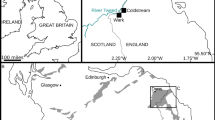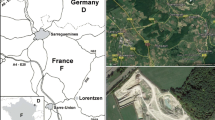Abstract
A very large alledged bustard, Otis hellenica (Boev et al. in Geol Balc 42:59–64, 2013), described from the Late Miocene of the continental Greece, is reinterpreted here as a member of Ergilornithinae (family Eogruidae), an extinct taxon of large cursorial gruiform birds convergently similar to ostriches. This is the western-most find of Ergilornithinae and the first documentation of this taxon in the continental Europe outside the territory of the former Soviet Union (Ukraine and Moldova). The Greek find is similar in size to coeval Urmiornis ukrainus from the northern Black Sea region, but is morphologically closer to the Early Miocene and even Paleogene Asian members of this group. This implies that the Balkan Peninsula was inhabited by a primitive lineage of Ergilornithinae in the Late Miocene, with less pronounced cursorial adaptations.
Kurzfassung
Eine sehr große mutmaßliche Trappe, O. hellenica (Boev et al. in Geol Balc 42:59–64, 2013), die aus dem oberen Miozän Kontinental-Griechenlands beschrieben wurde, wird hier nach einer Revision den Ergilornithinae (Familie Eogruidae) zugeordnet. Dieses ausgestorbene Taxon großer Laufvögeln entwickelte konvergent eine straußenartige Morphologie. Dies ist der westlichste Fund der Ergilornithinae und der erste Nachweis dieses Taxons in Kontinentaleuropa, außerhalb dem Gebiet der früheren Sowjetunion (Ukraine und Moldavien). Der griechische Fund ähnelt bezüglich seiner Größe der gleichzeitig lebenden Art Urmiornis ukrainus aus dem nördlichen Balkangebiet, aber morphologisch steht es frühmiozänen und sogar paläogenen asiatischen Ergilornithinae näher. Das zeigt, daß die Balkan-Halbinsel im späten Miozän von einer ursprünglichen Linie der Ergilornithinae bewohnt war, welche weniger ausgeprägte Laufanpassungen aufwies.



Similar content being viewed by others
References
Baumel, J.J., and L.M. Witmer. 1993. Osteologia. In Handbook of avian anatomy: Nomina anatomica avium, 2nd ed, ed. J.J. Baumel, 45–132. Cambridge: Publications of the Nuttall Ornithological Club 23.
Boev, Z.N., G. Lazaridis, and E. Tsoukala. 2013. Otis hellenica sp. nov., a new Turolian bustard (Aves: Otididae) from Kryopigi (Chalkidiki, Greece). Geologica Balcanica 42: 59–64.
Brodkorb, P. 1967. Catalogue of fossil birds. Part 3 (Ralliformes, Ichthyornithiformes, Charadriiformes). Bulletin of the Florida State Museum, Biological Sciences 11(3): 99–220.
Burchak-Abramovich, N.I. 1951. Urmiornis (Urmiornis maraghanus Mecq.) strausopodobnaya ptitsa gipparionovoi fauny Zakavkaz’a i yuzhnoi Ukrainy [Urmiornis (Urmiornis maraghanus Mecq.), an ostrich-like bird from the Hipparion fauna of Transcaucasia and southern Ukraine]. Izvestiya Akedemii Nauk Azerbaidzhanskoi SSR 6: 83–94 (in Russian).
Clarke, J.A., M.A. Norell, and D. Dashzeveg. 2005. New avian remains from the Eocene of Mongolia and the phylogenetic position of the Eogruidae (Aves, Gruoidea). American Museum Novitates 3494: 1–17.
Cracraft, J. 1973. Systematics and evolution of the Gruiformes (Class Aves). 3. Phylogeny of suborder Grues. Bulletin of the American Museum of Natural History 151: 1–127.
Feduccia, A. 1980. The age of birds. Cambridge: Harvard University Press.
Harrison, C.J.O. 1981. A re-assignment of Amphipelagus majori from Ciconiidae (Ciconiiformes) to Ergilornithidae (Gruiformes). Tertiary Research 3: 111–112.
Harrison, C.J.O., and C.A. Walker. 1982. Fossil birds from the Upper Miocene of Northern Pakistan. Tertiary Research 4(2): 53–69.
Karhu, A.A. 1997. A New Species of Urmiornis (Gruiformes: Ergilomithidae) from the Early Miocene of Western Kazakhstan. Paleontological Journal 31: 102–107.
Kozlova, E.V. 1960. Novye iskopaemye ptitsy iz yugo-vostochnoi Gobi [New fossil birds from south-eastern Gobi]. Trudy problemnykh i tematicheskikh soveshanii ZIN 9: 323–329 (in Russian).
Kurochkin, E.N. 1981. New representatives and evolution of two archaic gruiform families in Eurasia. Joint Soviet-Mongolian Paleontological Expedition, Transactions 15: 59–86 (in Russian).
Kurochkin, E.N. 1985. Birds of the Central Asia in Pliocene. Joint Soviet-Mongolian Paleontological Expedition, Transactions 26: 1–120 (in Russian).
Lazaridis, G., and E.A. Tsoukala. 2014. Hipparion phlegrae, sp. nov. (Mammalia, Perissodactyla): a new species from the Turolian Locality of Kryopigi (Kassandra, Chalkidiki, Greece). Journal of Vertebrate Paleontology 34: 164–178.
Mayr, G. 2009. Paleogene fossil birds. Berlin: Springer.
Olson, S.L. 1985. The fossil record of birds. In Avian biology, vol. 8, ed. D.S. Farner, J.R. King, and K.C. Parkes, 79–238. New-York: Academic Press.
Popov, S.V., F. Rögl, F.F. Steininger, I.G. Shcherba, and M. Kovac, ed. 2004. Lithological-Paleogeographical maps of Paratethys. 10 maps from Late Eocene to Pliocene. Courier Forschungsinstitut Senckenberg 250: 1–46.
Tsoukala, E., and A. Bartsiokas. 2008. New Mesopithecus pentelicus specimens from Kryopigi, Macedonia, Greece. Journal of Human Evolution 54: 448–451.
Zelenkov, N.V., and E.N. Kurochkin. 2011. Sovremennoe sostoyanie izuchennosti neogenovykh ptits Tsentralnoi Azii [The current state of knowledge of Neogene birds of Central Asia]. In A.Ya. Tugarinovu posvyashaetsya… Sbornik nauchnykh statei [Dedicated to A.Ya. Tugarinov. A collection of scientific papers], ed. N.V. Martynovich, 44–70. Krasnoyarsk: Krasnoyarskii kraevoi kraevedcheskii musei (in Russian).
Zelenkov, N.V., and E.N. Kurochkin. 2015. Class Aves. In Fossil vertebrates of Russia and adjacent countries. Fossil reptiles and birds. Part 3, ed. E.N. Kurochkin, A.V. Lopatin, and N.V. Zelenkov, 86–290. Moscow: GEOS (in Russian).
Acknowledgments
The laboratory work by NVZ was supported by a grant from the Russian Foundation of Basic Research (Project 14-04-01223). The authors are indebted to Dr. Gerald Mayr for the German translation of the abstract. NVZ further thanks Dr. Leonid Gorobets for assistance and access to fossil specimens in the collection of the National Museum of Natural History (Kiev, Ukraine). The authors further thank G. Mayr and an anonymous reviewer for valuable comments.
Author information
Authors and Affiliations
Corresponding author
Rights and permissions
About this article
Cite this article
Zelenkov, N., Boev, Z. & Lazaridis, G. A large ergilornithine (Aves, Gruiformes) from the Late Miocene of the Balkan Peninsula. Paläontol Z 90, 145–151 (2016). https://doi.org/10.1007/s12542-015-0279-z
Received:
Accepted:
Published:
Issue Date:
DOI: https://doi.org/10.1007/s12542-015-0279-z




